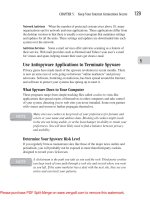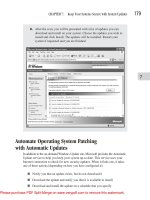How to Do Everything with Web 2.0 Mashups phần 4 ppsx
Bạn đang xem bản rút gọn của tài liệu. Xem và tải ngay bản đầy đủ của tài liệu tại đây (1.51 MB, 33 trang )
82 How to Do Everything with Web 2.0 Mashups
There is much more to SQL and database theory, but this is enough for you to manage the
basics of mashup data retrieval.
Create SQL Queries
SQL lets you retrieve data by using queries. A query starts with the keyword SELECT, and it
may include a variety of clauses. A SELECT statement always returns a table (although it may be
empty).
Here are some of the most basic SELECT uses.
SELECT * from mytable;
This selects all the rows and columns, and then returns them.
SELECT * FROM mytable WHERE age < 21;
This retrieves all the rows where the age column is less than 21.
SELECT name, address FROM mytable WHERE age < 21;
This retrieves only two columns (name and address) from the table, but the WHERE condition is
still enforced.
To join two tables (that is, to retrieve data from two tables at the same time), you generally
need to use a relationship. The employee example cited previously can be implemented in this
way.
SELECT personaldata, salarydata from personaltable, salarytable
WHERE personaldataID = salarydataID;
This can work provided the columns personaldataID and salarydataID are set up to have the
same values in the two tables for the same individual. This syntax is correct, but a problem can
quickly arise. As shown here, the assumption is the column names in the two tables are always
different. If they were not, sorting out the duplicate names would be confusing. To manage this,
you can associate an identifier with each table, rewriting the code as follows:
SELECT personaldata, salarydata from p.personaltable, s.salarytable
WHERE p.personaldataID = s.salarydataID;
The qualifiers p (for personaltable) and s (for salarytable) make the column names unique. In
fact, although this may appear as an extension to the basic syntax, the SQL rule is this: qualifiers
are required unless the names of the columns makes them unnecessary. Qualifiers often are one
character in length, but they can be longer. By using qualifiers, you can rewrite the statement to use
Simpo PDF Merge and Split Unregistered Version -
CHAPTER 7: Use MySQL with PHP to Retrieve Mashup Data 83
identical column names in the WHERE clause. This can be a good idea because it helps people to
understand that the columns in the two tables with the same name contain the same data.
SELECT personaldata, salarydata FROM p.personaltable, s.salarytable
WHERE s.employeeID = p.employeeID;
The keys need not be separate from the data retrieved. For example, the previous SELECT
statement can be rewritten to select personaldata, salarydata, and employeeID by writing it
as follows. Because the employeeID value is the same in both tables (that is the point of the
WHERE clause), you can retrieve whichever table’s value you want.
SELECT personaldata, salarydata, p.employeeID FROM
p.personaltable, s.salarytable WHERE s.employeeID = p.employeeID;
You frequently use a number of additional clauses in SELECT statements. A common one is
ORDER BY, which lets you sort data. Also of use in mashups is the FORMAT clause, which can
format data retrieved from the database. This can be easier than formatting it in PHP or another
scripting language.
To sort the table of returned data in the first example, you can use ORDER BY salarydata (or
any other field), as shown here:
SELECT personaldata, salarydata FROM p.personaltable, s.salarytable
WHERE s.employeeID = p.employeeID ORDER BY salarydata;
To format the salary data in whole dollars, you could use the FORMAT function. The
FORMAT function takes two parameters: the value to be formatted and the number of decimal
places.
SELECT personaldata, FORMAT (salarydata, 0)
FROM p.personaltable, s.salarytable
WHERE s.employeeID = p.employeeID;
If you want to display the salary with dollars and cents, you would use FORMAT (salarydata, 2).
Instead of retrieving the data, you can use the COUNT function to find out how many
records could be retrieved. COUNT is used in a SELECT statement in the following manner:
SELECT COUNT (employeeID) FROM salarytable WHERE salary > 30000;
This function normally is processed quite quickly, so you can easily see if you will be
retrieving 5 records or 500,000. If the number of records that would be retrieved is too great, you
can either stop the processing or prompt the user to modify the request. Other summary functions,
such as SUM, AVG, MAX, and MIN, are also available. Databases are optimized for performance,
and many of these operations can be carried out without reading the entire database. In modern
relational databases, a variety of indexes are created automatically or on request. Where possible,
queries are performed on the indexes rather than on the raw data.
7
Simpo PDF Merge and Split Unregistered Version -
84 How to Do Everything with Web 2.0 Mashups
Particularly when you are testing, you may want to arbitrarily limit the amount of data
retrieved. You can do that with the LIMIT clause. In the following code, you can never retrieve
more than ten records:
SELECT personaldata, FORMAT (salarydata, 0)
FROM p.personaltable, s.salarytable
WHERE s.employeeID = p.employeeID
LIMIT 10;
When the database is set up, each column is specified as to the data type it contains—text,
number, date, and so forth. This allows the database engine to optimize storage and searching.
Columns are sometimes called fields, and rows are sometimes called records.
This is the most basic overview of SQL, but for many mashups, this syntax is sufficient for
your needs.
Use the FEC Database
The FEC database used in this chapter, as well as in Chapters 12 and 13, contains three tables.
The FEC database is a typical example of a relational database, and it is used to illustrate how
tables are created and related to one another. Their feilds are shown in Table 7-1.
■ Candidates contains one record for each candidate. Each record has a unique value for
the candidate_ID. Also, each candidate’s record has a value for a committee_ID, which is
the identifier for that candidate’s committee.
■ Committees contains one record for each committee. Committees are linked to candidates,
which they support via the candidate_ID field in committees and candidates.
■ Individuals contains one record for each contribution. Individual contributions are linked
to committees, and then to candidates. The filer field in individuals is the committee_ID
value of the appropriate committee.
A database normally models some type of reality. In this case, the laws and regulations
of the FEC determine that a single committee exists for each candidate for the purpose
of reporting. If it were possible to have multiple committees for a candidate, an
intermediate table, called a join table, would be used.
To find the information on who contributed to which committees from a given ZIP code
(12901), this is the SELECT statement you can use. This performs a join based on the committees.
committee_ID field and the individuals.filer field, selects the ZIP code, and then sorts the data by
contributor name. Note, the FORMAT function is applied to the amount of the contribution, so no
digits are to the right of the decimal point.
Simpo PDF Merge and Split Unregistered Version -
CHAPTER 7: Use MySQL with PHP to Retrieve Mashup Data 85
SELECT
individuals.contributor,
committees.name,
committees.city,
committees.state,
FORMAT(individuals.amount, 0)
FROM individuals, committees
WHERE (individuals.zip = '12901')
AND (committees.committee_ID = individuals.filer)
ORDER BY individuals.contributor;
You learn how to use this code from PHP in the section “Use PHP to Get to an SQL Database.”
Each database table generally comes with documentation. When you download the
FEC data, note the short documentation files next to the data files. The documentation
is always important for a database. Only by reading the documentation would you
discover that committees.committee_ID and individuals.filer are the related keys.
Candidates
candidate_ID
name
party_1
party_3
seat_status
candidate_status
street_1
street_2
city
state
ZIP
committee_ID
year
district
Committees
committee_ID
|name
treasurer
street_1
street_2
city
state
ZIP
designation
type
party
filing_frequency
interest_group
connected_name
candidate_ID
Individuals
filer
amendment
report_type
primary_general
transaction_type
contributor
city
state
ZIP
occupation
transaction_date
amount
TABLE 7-1
The table fields
7
Simpo PDF Merge and Split Unregistered Version -
86 How to Do Everything with Web 2.0 Mashups
Use MySQL
MySQL is a widely used database that supports much of SQL. MySQL interacts well with PHP
using the mysqli module.
On both Windows and Mac OS X, MySQL uses a command line interface. On Windows, you
can select it from Programs in the Start menu.
On Mac OS X, launch Terminal and start MySQL by changing the directory to the /usr/local/
mysql directory, and then launching bin/mysql, as shown in Figure 7-1.
The syntax for launching MySQL on Mac OS X is
bin/mysql -u <yourusername> -p
The -p command tells MySQL to ask for a password. If you installed MySQL on Windows,
the installation process guides you through the steps of creating a new user. By default, the user
is root and the password is blank.
The commands are all terminated by a semicolon. Spaces do not matter, so you can spread
the commands over several lines. Remember, on both Mac OS X and Windows, you are working
with character-based interfaces, so you cannot go back several lines to correct a typo.
On the MySQL Web site, you can find a number of GUI interfaces available in the
Downloads section.
The general sequence of MySQL commands begins with USE <database>;. (Remember the
semicolon.) After that, enter your SQL commands that access that database.
A good idea is to always test your SQL statements interactively before coding them in
PHP.
FIGURE 7-1
Launch MySQL on Mac OS X
Simpo PDF Merge and Split Unregistered Version -
CHAPTER 7: Use MySQL with PHP to Retrieve Mashup Data 87
Use PHP to Get to an SQL Database
You now have almost all the pieces of the puzzle, so you can write the PHP code to query the
database and display the results. You saw the basics of the code in the previous chapter, but the
database sections were omitted. They are described here.
There are four database sections of code, which is true of nearly every programmatic access
of a database.
■ Connect to the database. You need to log in to the database manager and select the
database to use. This is comparable to executing MySQL and entering the USE statement.
■ Create the query and send it to the database.
■ Retrieve the results and display them.
■ Disconnect from the database.
Connect to the Database
Connecting to the database is boilerplate code, as shown here. If you are using an existing
database, your database administrator has the information you need to replace in this code. If
you are creating your own database, you can see how to do so (and how to set these values) in
Chapter 13.
<?php
$DB_Account = 'jfeiler'; // use your own account-name here
$DB_Password = 'password'; // use your own password here
$DB_Host = 'localhost'; // use the name of your MySQL host here
Get MySQL
Log on to to download MySQL. Several versions are available, but
you almost always want the MySQL Community Server—Generally Available Release.
Look for the Download button on the home page and follow the links. (One way of
determining if you are downloading the right product is to see if you can download it free.
For learning, testing, and small development projects, that is all you need.)
Separate installers are available for various operating systems. Use the appropriate
installer and, if you are installing MySQL for the first time, do not customize it until you are
familiar with its use.
7
Simpo PDF Merge and Split Unregistered Version -
88 How to Do Everything with Web 2.0 Mashups
$DB_Name = 'fec'; // use the name of your database here
$dbc = @mysqli_connect ($DB_Host, $DB_Account, $DB_Password)
or die ('Could not connect to MYSQL:'.mysql_error());
@mysqli_select_db ($DB_Name)
or die ('Could not select the database:'.mysql_error());
?>
For readability and maintainability, variables are used for the user name, password, host,
and database name. When database security is set up, you may want to create a user name and
password used solely for access from programs and scripts. This is so the privileges associated
with that user name can be separated from privileges assigned to an interactive user.
The local host is assumed as the location of the database, however, you can supply an IP
address instead and that is where the connection will be made.
It the connection cannot be made or the database cannot be selected, the PHP script dies with
the appropriate message. Note the concatenation operator (.) used to display the specific error
string returned by the MySQL calls.
Because this is standard code and also because it contains password information, a good idea
is to place it in an include file, so the main PHP script does not contain confidential information.
If you do this, the beginning of the PHP script will include this line of code:
include ('Includes/SQLLogin.php'); // this contains the boilerplate
code shown at the beginning of this section
Create and Process the Query
The next step is to create the query. You need to retrieve the selected ZIP code from the form
submitted. That is done by setting the local variable $zip. Next, a query string is created. As you
can see, it is spaced out for readability. This is exactly the string used to test in MySQL, except
the ZIP code is not hard-coded. Instead, the ZIP code is concatenated with the $zip variable.
// Query the database.
$zip = $_REQUEST['zip'];
$query = "SELECT
individuals.contributor,
committees.name,
committees.city,
committees.state,
FORMAT(individuals.amount, 0)
FROM individuals, committees
WHERE (individuals.zip = '"
.$zip.
"') AND (committees.committee_ID = individuals.filer)
ORDER BY individuals.contributor
Simpo PDF Merge and Split Unregistered Version -
CHAPTER 7: Use MySQL with PHP to Retrieve Mashup Data 89
LIMIT 10";
if ! ($result = mysqli_query ($query))
die (' SQL query returned an error:'.mysqli_error());
Because this code is to be used for testing, the LIMIT clause is added at the end of the query.
The variable $result receives the result of the query. This is not the data. Instead, it is the result of
the call that will be either TRUE or FALSE.
Fetch the Data
If the result of the query is good, you then need to fetch the data and display them using HTML.
The first section of code here creates the HTML table to be used to display the data:
echo '<table border="0" width="100%" cellspacing="3"
cellpadding="3" align="center">
<tr>
<td>Contributor</td>
<td>Recipient</td>
<td>Recipient City</td>
<td>Recipient State</td>
<td>Amount</td>
</tr>';
Now you display the data. The key here is the WHILE statement and its call of mysqli_
fetch_array. This returns each row in turn, placing the row into the $row variable. You can then
access the individual elements to place them in the HTML code. If you want, you can modify the
data. For example, although the contributor name is retrieved (in $row[0]), it is not displayed.
Instead, the string -name- is used to hide those data. Note, also, the amount is aligned to the right
in the last column (the amount was formatted in the SQL query).
In reality, there is no reason to retrieve data that you do not want to display as is
the case with the name field in this example. However, some data might be partially
masked, such as the common situation in which the last few numbers of a credit card
are displayed with the previous numbers represented as asterisks. In this case, although
the data are in fact public, they are not displayed in the screenshots. If you use the
sample code, you can change this line of code to display the real names in your mashup.
// Display all the values.
while ($row = mysqli_fetch_array ($result, MYSQL_NUM)) {
// Display each record.
echo " <tr>
<td>-name-</td>
<td>$row[1]</td>
<td>$row[2]</td>
7
Simpo PDF Merge and Split Unregistered Version -
90 How to Do Everything with Web 2.0 Mashups
<td>$row[3]</td>
<td align=\"right\">$row[4]</td>
</tr>\n";
} // End of while loop.
echo '</table>'; // End the table.
Disconnect from the Database
Finally, you disconnect from the database. This is a single line of code, but, for readability, and
in case you need to do additional processing, it is placed in its own include file.
<?php
mysqli_close(); // Close the database connection.
?>
This means the end of the PHP file includes this line of code, with Includes/SQLClose.php
containing the call to mysqli.close().
include ('Includes/SQLClose.php'); // Close the database connection.
Create and Load a Test Database
This section describes how to create a database in MySQL and populate it with tables and
data. In Chapters 11 and 13, you see how to download specific data from the Federal Election
Commission and the Census Bureau to populate database tables.
Create a Test Database
The first step in creating a database is just that—create it. In MySQL enter the following
command (you can name the database something more meaningful than test if you want):
create database test;
Once you create a database, you can USE it:
use database test;
Once you have a database, you can create one or more tables within it. Each table you create
must have at least one column, so the minimal syntax is
create table testtable (name varchar (5));
This code creates a table called testtable; it has one column, which is called name. That
column is set to be a variable-length character field of up to five characters. By using varchar
instead of a fixed field length (which would be char), you can avoid storing blank characters.
Simpo PDF Merge and Split Unregistered Version -
CHAPTER 7: Use MySQL with PHP to Retrieve Mashup Data 91
Then, add whatever columns you want. Because MySQL is character-based, you cannot go
back to fix a typo on a previous line you entered into it. For that reason, it may ultimately be
faster to add each column individually, rather than typing several lines of code, which may fail.
Here is the basic syntax to add a column:
alter table testtable add column address varchar (5);
If you download the FEC data, you can construct tables that match the downloaded
data exactly. If you are using those data, remember, they are not always cleaned.
Because of this, you may be better off not declaring date columns as type date but,
instead, as character fields. In that way, if you have invalid date data, you will not
generate errors. This tip applies to any data you use: field types may often be goals,
not reality in downloaded data.
To see what you created, you can always check to see what the table looks like:
describe testtable;
This produces the output shown in Figure 7-2.
MySQL supports standard data types. For a description of the supported types, see http://dev
.mysql.com/doc/refman/4.1/en/data-types.html.
Load the Test Database
If you create tables for the downloaded data, filling them with the data themselves is easy.
MySQL supports fast importing with the LOAD DATA INFILE command.
The full syntax for LOAD DATA, as well as feedback from users, is located at http://dev
.mysql.com/doc/refman/5.1/en/load-data.html for MySQL version 5.1 in English. If you
go to , and then click on Documentation, you can search for LOAD
DATA INFILE to find all articles in all languages for all versions of MySQL.
The LOAD DATA INFILE command lets you quickly load a table from a flat file. The basic
syntax for the LOAD DATA command specifies the file, the table to load, and the way in which
the input data are to be split apart. The order of the clauses in the LOAD DATA INFILE command
matters, although beyond the basic syntax shown next, all the clauses are optional.
FIGURE 7-2
The result of a describe command
7
Simpo PDF Merge and Split Unregistered Version -
92 How to Do Everything with Web 2.0 Mashups
Basic LOAD DATA INFILE Syntax
For example, here is one of the simplest LOAD DATA commands:
load data infile local myData.txt
into table myTable;
The local keyword tells the command to search for the file locally (that is, on the computer
where you are running MySQL, rather than where the database is running). If you want to load
a file from the server where the database is running, just omit the keyword. Note, in reality, you
need a fully qualified file name (that is, one with the full path specified).
The into table clause means exactly what it says.
The defaults, which are assumed here, are as follows: the lines of data are terminated with
newline characters, and the fields are terminated with tab characters. Further, the assumption is the
input data contain values for the columns of the table in the order in which they are described in
the database (you can check on this with the describe table command).
Changing Field and Record Delimiters
If fields are terminated by a character other than a tab, you can specify what that character is.
Likewise, you can specify the terminator of each record. In the following code, the fields are
terminated by a vertical line (the | character), and the records are terminated by a newline character:
load data infile local myData.txt
into table myTable
fields terminated by '|'
lines terminated by '\n';
To load data where the fields are terminated by a tab character (\t) and the records are
terminated by a return, you would use
fields terminated by '\t'
lines terminated by '\r'
Note, the line and field terminators are often single characters such as the tab, a comma, or
a return character. However, the actual specification shows they are strings.
Ignoring Records
The ignore clause uses the line termination characters to determine what to ignore (if anything)
at the beginning of the file. This is useful if the first few records of the file contain headings or
other descriptive information. As long as each line is terminated with the same character used for
the subsequent data records, you can jump over those non-data records.
The following code skips over the first two records of the input file:
load data infile local myData.txt
into table myTable
Simpo PDF Merge and Split Unregistered Version -
CHAPTER 7: Use MySQL with PHP to Retrieve Mashup Data 93
fields terminated by '|'
lines terminated by '\n'
ignore 2 lines;
If your data load does not work at all or only loads one record, check the line
terminator character. Without further investigation, you can simply switch it from
newline to return, or vice versa, which often solves the problem.
Loading Specifi c Columns
The load data command loads data into the records of the table in the same order the data appear
in the input record. If you want to reorder the data or skip over some columns, however, you can
do so by using a column/variable list.
A column/variable list is enclosed in parentheses and specifies the columns to be loaded. The
data in the input file are processed based on the field and record delimiters that are specified.
Then, the first data field is placed in the first column in the column/variable list, the second in the
second, and so forth.
For example, the following code places the first field of the file in column 5, the second field
in column 1, and the third field in column 12. The balance (if any) of the fields is ignored.
load data infile local myData.txt
into table myTable
fields terminated by '|'
lines terminated by '\n'
(column5, column1, column12);
Loading Data into Variables to Skip Columns
You can also load data into variables during the load process. Variables are specified beginning
with @. They can be included in the column/variable list. If you want to load the first field into
column 5, the second into column 1, and the third into a variable, you could change the last line
of the code just shown to this:
(column5, column1, @myVariable)
One reason to do this is to use variables to skip over data. If you want to load the first field
into column 5 and the third (not second) field into column 2, you need a way to skip over the
second field in the input file. You can do so with this code:
(column5, @myVariable, column2)
You can skip over several fields from the input file by loading them into multiple variables—
or even the same one:
(column5, @myVariable, column1, @myVariable, column12)
The variables used in this way are not stored anywhere.
7
Simpo PDF Merge and Split Unregistered Version -
94 How to Do Everything with Web 2.0 Mashups
Setting Data During the Load Process
One of the important features of the LOAD DATA INFILE command lets you set a column to the
result of a calculation. Calculations can involve columns, constants, and variables. For example,
to set a column named myValue to half the input value read into column 3, you could use
SET myValue = column3 / 2
If you use a variable in the column/variable list, you can include it in a calculation, such as
the following:
SET column3 = @myValue / 2
Reading Fixed-Width Data
You often find data with no delimiters. The documentation tells you the first field is characters
1–12, for example, and the second field is characters 13–20. You can handle this situation by
reading the continuous data into a variable, and then splitting it apart. The following code does
this:
load data infile local myData.txt(
into table myTable
lines terminated by '\n'
(@unDelimitedText)
SET column=substring(@unDelimitedText, 1, 12),
column2=substring(@unDelimitedText, 13, 8);
You can combine various features of LOAD DATA INFILE, such as in this command, which
is used in Chapter 11, to load some census data into a table. Note the realistic file path name, as
well as the field and line delimiters. You can see seven fields are read from the input file (there
are more fields in the file, but the remaining ones are skipped). The first and third fields are
stored in variables that are not used. The second field is stored in the variable $geocode and is
then split apart. The fourth, fifth, sixth, and seventh variables are read into columns without any
adjustment.
load data infile local
'/Users/jfeiler/Desktop/dc_dec_2000_sf1_u_data1.txt'
into table population
fields terminated by '|'
lines terminated by '\n'
ignore 2 lines
(@var1, @geocode, @var2, County_Name,
TotalPopulation, TotalMen, TotalWomen)
set State_FIPS_Code=left(@geocode, 2),
County_FIPS_Code=right(@geocode, 3);
Simpo PDF Merge and Split Unregistered Version -
CHAPTER 7: Use MySQL with PHP to Retrieve Mashup Data 95
Delete Data from the Test Database
Loading data can be fast and efficient, but as is always the case in transferring data from one file
or format to another, you may need several tries to get things right. Three commands can help
you at this point.
Review the Data
You can select all the data in a table with a simple SELECT command. If you use the LIMIT
keyword, you can check the first few records, as in the following syntax:
SELECT * from myTable LIMIT 10;
The LIMIT keyword can be followed by two numbers. If this is the case, the first number is
the first row to display, and the second number is the number of rows. (Note, rows are numbered
from zero.) Thus, if you enter this code, you can view ten records, starting with record number
10,000 (which is the 10,001
th
record starting from zero):
SELECT * from myTable LIMIT 10000, 10;
A good idea is to check the first few records and the last few records. Just as some extraneous
records might be at the beginning of a file that you can skip over with IGNORE, you may also
find some extraneous records at the end.
Delete Data from the Table
If you want to try again after a load that did not work quite right, deleting records from the table
is simple. To delete all of them, use this syntax:
DELETE from myTable;
Drop the Table
You can drop the table from the database, which removes it totally. If you merely need to adjust
columns, you can use the ALTER TABLE command:
DROP table myTable;
Drop the Database
Finally, you can drop the entire database, all its tables, and all its data. You should obviously be
careful about doing this, but if you have been testing, there are times when you want to start over.
DROP database myDatabase;
7
Simpo PDF Merge and Split Unregistered Version -
This page intentionally left blank
Simpo PDF Merge and Split Unregistered Version -
Chapter 8
Use RSS and Atom to Receive
Data Automatically
Simpo PDF Merge and Split Unregistered Version -
98 How to Do Everything with Web 2.0 Mashups
How to . . .
■ Understand Syndication, RSS, and Atom
■ Parse a Feed with PHP
■ Create a Search Feed
I
n Chapter 4, you saw the basics of XML, which is the basis of almost all news feeds. And, you
saw how news readers can take the data apart and enable users to interactively sort and resort
it by date or subject.
This chapter returns to XML and news feeds to examine how they can be used to drive
mashups. Mashups almost always work with large amounts of data, even though only a small
subset may be used for a particular mashup to map a location or merge two data items from two
sources with one another. In the previous chapters, you saw how to use PHP and databases to
enable the user to select data to be retrieved.
At the other extreme of the architecture is a mashup based on a news feed. In such cases,
users do not select the data at all. Instead, a news feed delivers data to the mashup, and the
mashup takes whatever is delivered and works with it. Some news feeds are traditional news
feeds generated by newspapers or broadcasters, as well as by bloggers, social networking sites,
and organizations large and small that want to send out their information. Other news feeds are
designed for mashups. The latest blogs and Flickr’s latest photos are of interest to point-and-click
users, but they are valuable resources for mashup authors.
This chapter shows you how to examine a news feed with PHP and to extract its data, so you
can then use it in your mashup. Chapters 16 and 17 show you how to apply the architecture and
techniques in this chapter to a Flickr news feed, but, remember, although that example uses a
Flickr news feed, the architecture and technology can work with any news feed.
You can also create feeds that represent dynamic searches on services such as Yahoo! and
Google. You see how to create these searches yourself. You can then use the techniques for
parsing static feeds to parse the results of your searches.
Find More Information About RSS
and Atom
For more information on RSS, go to The specification
for the Atom format is available at />format-spec.php.
Simpo PDF Merge and Split Unregistered Version -
CHAPTER 8: Use RSS and Atom to Receive Data Automatically 99
Understand Syndication, RSS, and Atom
Like mashups, syndication brings together a variety of basically simple Web technologies to
create something new and more powerful than the individual components. Syndication allows
publishers (be they journalists or bloggers) to generate XML documents called feeds describing
the content of their Web site. Typically, these XML feeds list the latest items on the Web site, but
they need not do so. Small badges on Web sites indicate they support syndication feeds to which
you can subscribe.
Because feeds are automatically generated from blogs and other publishing tools, they
are low-maintenance ways of exporting information. In the last few years, users have been
encouraged to tag or otherwise categorize blogs, photos, and other items. That identifying
information finds its way into feeds.
Two competing formats exists for feed syndication today: RSS and Atom. Referring to them
as “competing” is likely to cause one of those philosophical wars that only computer people
seem able to sustain. Both formats accomplish the same thing: creating syndication feeds, but
they do so in slightly different ways. Both are dialects of XML. As a result, in today’s world,
both feeds are available, often for automatic feed generation based on the user’s choice.
RSS
RSS, which is an acronym for Really Simple Syndication (and originally for RDF Site Summary,
where RDF stands for Resource Description Framework), is the older format and by far the simpler
of the two. It is basically frozen at version 2.0.1, and is described at />tech/rss. RSS is managed by Berkman Center for Internet & Society at Harvard Law School.
A typical RSS feed is shown as formatted in the Safari news reader on Mac OS X in Figure 8-1.
Figure 8-2 shows the beginning of the XML code that makes up the feed.
The XML code is shown in a version of Firefox that does not support the formatted
display of news feeds so you can see the code itself. Firefox presents the XML with hyphens,
indentation, and linefeeds, none of which are part of the raw XML. The beginning of the actual
XML file shown in Figure 8-2 has none of those features, as shown here.
<?xml version="1.0" encoding="UTF-8"?>
<rss version="2.0">
<channel>
<title>NYT > Theater</title>
<link> /> index.html?partner=rssnyt</link>
<description></description>
<language>en-us</language>
<copyright>Copyright 2007 The New York Times Company</copyright>
<lastBuildDate>Tue, 20 Feb 2007 13:05:01 EST</lastBuildDate>
<image>
<title>NYT > Theater</title>
8
Simpo PDF Merge and Split Unregistered Version -
100 How to Do Everything with Web 2.0 Mashups
<url> /> NytSectionHeader.gif</url>
<link> /></image>
…
The first line of the file (as in all such listings in this book) is not shown in the Firefox
display. It is always
<?xml version="1.0" encoding="UTF-8"?>
An RSS feed is a structured XML document with certain required elements.
■ The entire feed is contained in an rss element, which must have a version attribute.
■ Within the rss elements, there must be one and only one channel element. Within the
channel element in Figure 8-2 you see a title, a link, and other general elements that
apply to it. Then, you see a sequence of items within the channel. Each of the items has
FIGURE 8-1
New York Times RSS feed in Safari
Simpo PDF Merge and Split Unregistered Version -
CHAPTER 8: Use RSS and Atom to Receive Data Automatically 101
its own link, title, and so forth. You will see how to parse them out in the section “Inside
the Feed’s XML Document.”
■ In addition to the channel element, any number of item elements may occur. Each item
element is a story, blog entry, or other component of the feed or channel.
Atom
The Atom format is not frozen the way RSS is. It is more powerful or complicated (depending
on which side of the theological war you are on), and it is still evolving. The specification for the
Atom format is available at />spec.php. In Figure 8-3, you see an Atom feed in Safari.
This feed is generated automatically by the Blogger software. In Figure 8-4, you can see the
beginning of the Atom XML document displayed in Figure 8-3.
The main elements of the Atom feed are the feed element and the entry elements.
FIGURE 8-2
XML code for the New York Times RSS feed
8
Simpo PDF Merge and Split Unregistered Version -
102 How to Do Everything with Web 2.0 Mashups
The feed element is comparable to the rss element in RSS. There is no channel element.
Instead, the elements that would be in an RSS channel element are placed within the feed
element itself. Atom has no item elements. They are, instead, called entry elements.
Categorize and Label a Feed
One of the things that makes feeds so useful is they can be created when the content is created.
Rather than go back and mark up articles and text, the semantic elements can be created
automatically, and then formatted appropriately by blogging or publication software. The addition
of categories and labels adds value to the feed, and it represents an almost trivial amount of effort
when the information is published. Figure 8-5 shows how a label can be attached to a Blogger
posting. At the bottom of the posting, you select a label or type in a new one. (Labels are most
effective when they are single words without spaces.)
As you can see in Figure 8-6, the labels for a posting are shown on the blog page. Clicking
on the label automatically retrieves other posts with the same label.
FIGURE 8-3
Blogger blog Atom feed in Safari
Simpo PDF Merge and Split Unregistered Version -
CHAPTER 8: Use RSS and Atom to Receive Data Automatically 103
A news feed reader, such as the one in Internet Explorer 7, can sort feed elements by
categories (which is what the labels are), as shown in Figure 8-7. In addition, some blogging
software such as Blogger can incorporate the label/category into the URL. In the Blogger style,
add /-/<labelname> to the end of the URL. Thus, for a blog published at pickwickpixels.com,
you can select postings with the label roundtable by entering
/>Parse a Feed with PHP
In the previous chapter, you saw how to write a PHP script to execute a database query, and then
parse the results. When you are dealing with a news feed, the “query” is implicit in the URL of
the feed, so you have one less step. Also, because the data are returned as an XML document,
your parsing and displaying of the data relies not on extracting rows from an SQL results table,
but on parsing the XML. This section shows you how to do this.
FIGURE 8-4
XML code for the Blogger Atom feed
8
Simpo PDF Merge and Split Unregistered Version -
104 How to Do Everything with Web 2.0 Mashups
This section covers the basics for both RSS and Atom.
Two files are included on the book’s Web site that implement this example:
■ index3.html is the starting page. It contains a form submitted to run the PHP script.
■ parsefeed3.php is the script launched from the submitted form.
Inside the Feed’s XML Document
That parsing of the XML document is built into the DOM module of PHP 5 and later.
Before PHP 5, the DOM XML module was used. The examples in this book all assume
PHP 5 and DOM, not DOM XML.
FIGURE 8-5
Add a label to a Blogger posting
Simpo PDF Merge and Split Unregistered Version -
CHAPTER 8: Use RSS and Atom to Receive Data Automatically 105
You can find the full documentation at , but the basics are quite simple.
■ Get the XML Document
■ Convert it to a DOM Document in PHP
■ Generate Lists of Elements for Entries or Items
■ Process Each Element
Get the XML Document
First, you retrieve the XML document, usually by using a URL. The curl library of PHP is used
to issue the call to get the contents of a URL and place the contents in a string.
FIGURE 8-6
Labels show up on blogs
8
Simpo PDF Merge and Split Unregistered Version -
106 How to Do Everything with Web 2.0 Mashups
The curl library is not always compiled into PHP if it is already installed on your
computer. Check to see if the code works properly. If it does not, refer to the PHP
documentation for instructions about enabling curl ( />.curl.php). Note, as in many PHP features, what was optional in an earlier release and
required custom installation often is standard in a later release.
Here is the code to load the XML document:
$theURL =
" />$c = curl_init($theURL);
curl_setopt ($c, CURLOPT_RETURNTRANSFER, 1);
$xml = curl_exec($c);
curl_close($c);
FIGURE 8-7
Categories/labels in Internet Explorer’s news feed window
Simpo PDF Merge and Split Unregistered Version -









